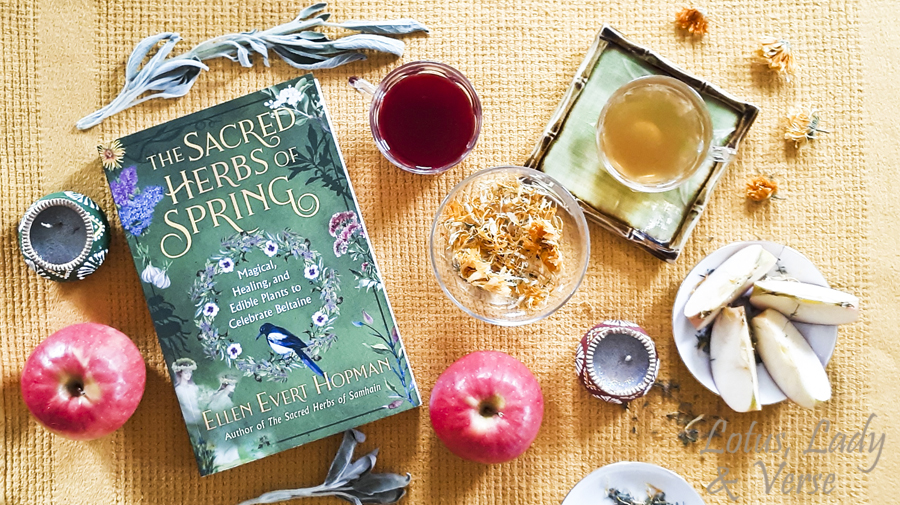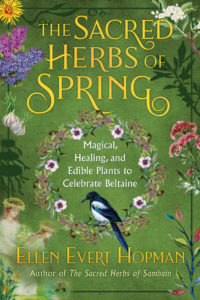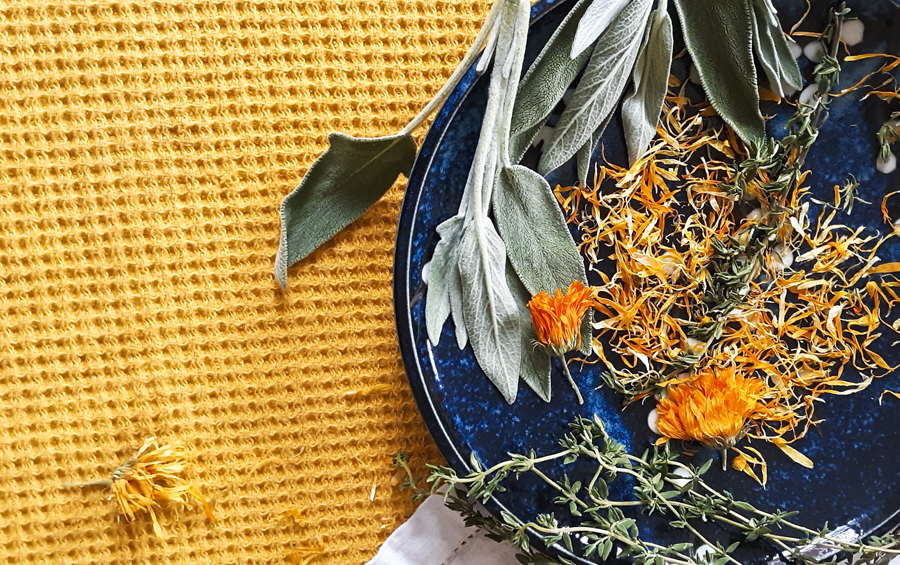Celebrate May 1st, also known as Beltaine, with festive flowers—the symbols of renewal and rebirth we love in trees, flowers and herbs.

My impression of this new book by a master herbalist is that the author invites, no, urges us all (all of us, everyone) to connect with the bounty of nature and honor this connection, no matter how inexperienced.
 Sacred Herbs of Spring: Magical, Healing and Edible Plants to Celebrate Beltaine. / Ellen Evert Hopman, 2020. Destiny Books, an Imprint of Inner Traditions International. 340 pages, illustrations in color.
Sacred Herbs of Spring: Magical, Healing and Edible Plants to Celebrate Beltaine. / Ellen Evert Hopman, 2020. Destiny Books, an Imprint of Inner Traditions International. 340 pages, illustrations in color.
In our busy urban lives, we tend to be disconnected from any and all relationships with nature. As a consequence, we are unaware of the richness of the natural world that surrounds us. Or that the flowers—showy, blooming and beautiful in late spring—are a festival of life.
Yet, you may remember a certain Halloween, costume party, or those celebrations where we applaud the milestones in each other’s lives. In Sacred Herbs of Spring, Beltaine is an ancient ritual brought forward to our times for festivity and celebration, as well as to petition the gods for our wishes.
Celebrating a New Season
Beltaine is an Irish / Scottish term for the First of May, that sweet and expectant moment when late spring turns towards summer, when the natural world is ready to burst with fruitfulness. In ancient cultures, a celebration always preceded seasonal change. Especially regaled at Beltaine, on or about May 1st, events of the new, growing things like herbs and trees are living examples of rebirth and life renewal.
Knowledge about herbs, flowers, plants and trees is good to have. But if you’re lacking that, then a spirit helper or ally might be welcome. They can show you the way.
Spirit helpers
At Beltaine, or any time of year, the peoples of the Northern areas of Europe and the British Isles believed they could rely on fairies, or little unseen beings. Hopman’s accounts of spirit allies, or fairies, explains their inventive ways. She says fairies are not just cute and mischievous little beings, in fact they perform all kinds of chores, grant wishes, and watch over you! Spirit allies can be very helpful, if you believe in their ability to see where, or do what, we cannot. (Actually, I have no idea—but may find out soon—whether I believe in them or not!)
Apples and Violets
We might think it doesn’t matter that apples, a fruit we enjoy eating out of hand, in smoothies, desserts and cooked in so many ways, used to represent a means to connect with spirits in the afterlife. Or that the regal but shy violet used to stand in as a code for love, a season before roses even think of blooming. Or of trees—whose wood represents the alchemy of natural forces—we hardly know their mastery of the unexpected.
Thyme, herb for coughs or for love
Sacred Herbs of Spring is a collection of beliefs about plants, herbs, flowers and trees. 70 herbs are storied in the book. For example, thyme, a favorite now for immunity, is also an herb of “magic and mysteries”—a plant that forms a bridge between life on earth and life after death—that due to its scent, is a favorite of the fairies. Thyme can bring you good fortune and fame, albeit informally, by “increasing your vitality” and “lifting your spirits” p. 90 Another way to identify the benefits of an herb, these sound like promises yet are casual, non-scientific descriptions of plant constituents. Hopman shares medicinal aspects, such as thyme’s affinity for the respiratory, digestive and nervous systems. In short, thyme, like many herbs, offers a pharmacopeia for the human body and psyche.
Hopman asserts that you needn’t be a gardener to fully appreciate the season or to celebrate Beltaine. Foraging for them yourself or procuring your herbs or flowers from a market, work equally well. Like a compass, Sacred Herbs directs your attention to using herbs like Violets to bring love or healing into your life. And there are different ways you can do this, as Hopman says, from garnering the interest of “fairies, elves and spirits”, to identifying herbs that “protect, purify, and give courage”, to aiding in your “connection with higher beings”, and more.
Bright Gold Forsythia, or Marigold
Consider the magical floral syrup of Forsythia blossoms, a golden treat. Or look for more in “Herbs for Love, Fertility and Abundance” which features, apples, clovers, beans, and rose, thyme, violets and yarrow, among others.

So if you’re looking for the festive aspects of an herb, flower or tree, you’ll find them here, along with recipes for Candied Flowers of Cherry blossoms, Marigold Cheesecake, and a wide variety of cordials, beers, wines, meads with elderflowers, dandelion, fir tips, and so on… an assortment of contexts through which you can imagine celebrating the beauty of Beltaine. Herbs with special affinities for our psychic needs, emotional strength and release are certainly found in Sacred Herbs of Spring, along with playful fancies, like “Wisteria and Redbud Spring Rolls” p. 197.
Sacred Herbs of Spring is a reference of knowledge about our favorite species, handed down to us through ritual as well as written history. Largely a book of recipes and uses, instructions for brewing teas, and taking care of your health, the popularity of dishes and condiments of a variety of cultural origins have come down to us through the ages. These are seen in recipes like Four Thieves Vinegar and Chinese Hot and Sour Soup with Wood Ear Mushrooms.
Druid and Celtic
It’s the Druidic and Celtic background of the author (her biography can be seen here) and her experience with herbs, flowers, plants and trees as medicinal allies, that add color and imagination to the text.
Serving to heighten the historical aspect of this herbal collection, 24 plates of botanical watercolors illustrate the herbs. Many of Hopman’s references are to websites, which makes it easy for you the reader to explore more.
If you embrace a nature religion, then you honor nature’s creative force and assign your wishes to the powers expressed by the herbs, plants, and trees. To do this, follow the instructions in Sacred Herbs of Spring’s brief descriptions of how to enjoy that herb when celebrating Beltaine.
See Ellen Evert Hopman’s website, here.
Follow


